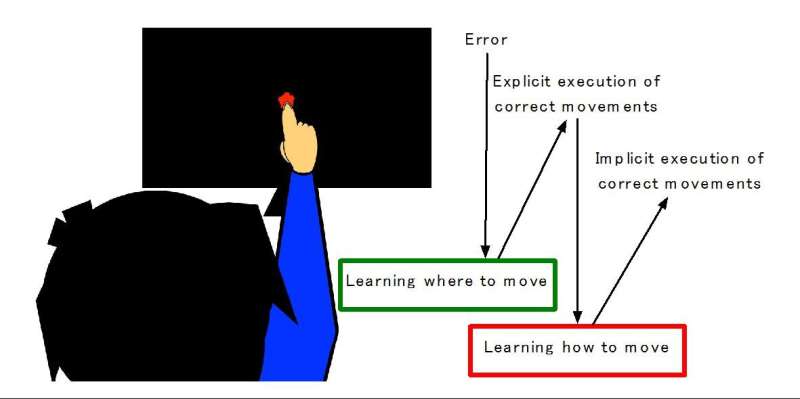When subjects wore the prism glasses, they touched rightward from the targets. However, after repetitive hand-reaching movements, they learned where to move from the error between the touching point and the target's point. As a result, they explicitly touched the targets. Note that they could not implicitly touch the targets at this stage. After repetitive explicit executions of correct movements, they implicitly touch the targets without thought. Credit: Tokyo Metropolitan Institute of Medical Science
Scientists at Tokyo Metropolitan Institute of Medical Science, RIKEN, National Center of Neurology and Psychiatry, Nozomi Hospital and Tokyo Medical and Dental University have identified acquisition of two types of internal models for motor control that are likely to be stored in the cerebellum. They show that motor control in hand-reaching movements relies on two types of motor learning: (i) acquisition of explicit motor control and (ii) acquisition of implicit motor control.
It is generally accepted that precise motor control depends on the acquisition of an internal model. There are two hypothetical internal models for motor learning: the calculation of destination for a given motor command, or the calculation of motor command for a target. For 30 years, there has been longstanding controversy over which internal model is actually working in the brain.
Lead author Takeru Honda, Ph.D. and his co-authors thought that both internal models are necessary to execute precise movement—if the destination is known, the brain has to update the mapping from the motor command to the destination of movement. If a target object is known, the brain has to update the mapping from the target (destination) to the proper motor command. Subjects in the study repeatedly made a reaching movement to touch a target on a touchscreen with the index finger. Then they wore prism glasses that shifted their vision rightward. During initial 10 trials with the prism glasses, they were not able to touch the target precisely. Instead, they touched points shifted rightward from the target.
After repetitive trials, they eventually learned to touch the target precisely. In this paradigm, the authors found learning elicited by correct touching on the targets and hidden learning elicited by the error between the touch position and the target position. They also provided a theory and a simple empirical formulation. Their results show that learning where to move is necessary for explicit execution of correct movements, while learning how to move is necessary for implicit execution of correct movements. Furthermore, their theory predicts that cerebellar damage induces an impairment of "where to move" or an impairment of "how to move." Indeed, the researchers found both types of deficits in cerebellar patients by evaluating them with clinical indexes developed for the study.
Therefore, applications of this finding may contribute to clinical tests to evaluate learning capabilities of different types of cerebellar patients. The test will measure effects of rehabilitation techniques or novel therapies for cerebellar ataxia. In sports, the results will also help to develop effective methods of training for top athletes.
More information: Takeru Honda et al, Tandem internal models execute motor learning in the cerebellum, Proceedings of the National Academy of Sciences (2018). DOI: 10.1073/pnas.1716489115
Journal information: Proceedings of the National Academy of Sciences
Provided by Tokyo Metropolitan Institute of Medical Science
























